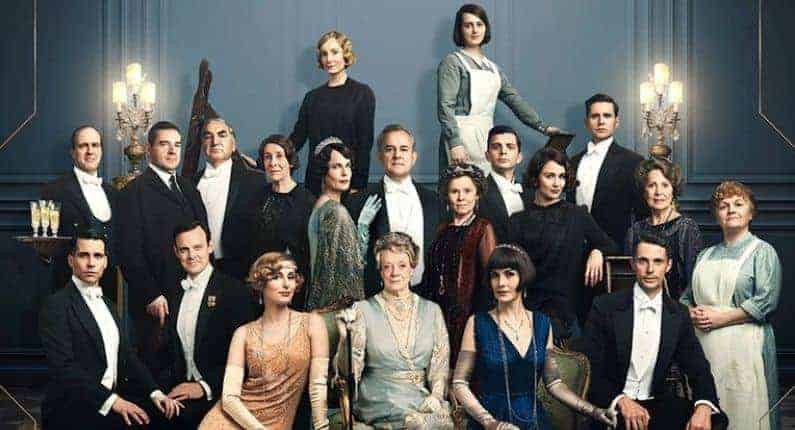

A Guide to Downton Abbey Etiquette
- Ase Anderson
- September 11, 2019
- A Guide to Downton Abbey Etiquette
- No Comments
The trials and tribulations of the aristocratic Crawley family captivated audiences around the world for six seasons before culminating in a record-breaking finale on Christmas Day 2015.
This week Lord Grantham, Lady Mary and the other characters in the British period drama are reunited on the big screen thanks to the highly-anticipated release of the Downton Abbey movie. Once again the spotlight is not only on the elaborate costumes and grand homes of Britain’s landed gentry, but also on the strict etiquette rules that regulated all social interactions in the post-Edwardian era.
The ITV drama employed etiquette expert and historian Alastair Bruce to ensure that every single detail – from table settings to facial expressions – accurately reflected the period between 1912 and 1926. In a documentary entitled ‘The Manners of Downton Abbey’, Mr Bruce said: “Manners came into everything: how you dressed, how you ate, how you stood, how you spoke—every detail mattered. It said who you were, and where you belonged: if you were from above stairs or below.”
Dining Etiquette
While many of the Downton Abbey dining etiquette rules are timeless and still apply today, other customs, such as wearing hats and gloves for all meals before 6pm, are no longer relevant. The tradition of women retiring to the parlour for coffees and liquor to allow the men to talk about politics has also been dispensed with.
If you were invited to a formal dinner at Downton Abbey, you would be well advised to bear the following etiquette rules in mind:
- Do not sit down until the hostess takes her seat. Remain seated behind your chair and then move to the right of the chair and sit from the left.
- When the hostess places her napkin on her lap, that’s your signal to do the same. A napkin should never be tucked into your shirt; it belongs on your lap.
- Your back should never touch the chair and you must not bring your mouth towards the table to eat.
- You should not pass comment on the food (because it was cooked by the chef, not the Lady of the house).
- Only married women were allowed to wear tiaras to formal dinners. These tiaras had often been gifted to them on their wedding day and helped to distinguish the married women from the single women.
Social Etiquette
The focal point of the social calendar was the London ‘Season’. Every May, wealthy aristocrats would leave their country houses and travel to their London residences for a three-month whirl of balls, parties and events, that lasted until the end of July.
All social interactions, formal or informal, were occasions that required a complex set of rules to govern behaviour. Talking about money was off limits, and similarly you would not ask someone what they did for a living. Other conversation topics best avoided included sex, health, politics and religion.
People would greet each other with a bow or courtesy rather than a handshake, and under no circumstances would one engage in overt displays of affection such as hugging or social kissing. Emotions were always kept under control and any spontaneous outbursts of joy, anger or sorrow would have been frowned upon.
Correct titles and forms of address had to be used at all times. For example, the Earl of Grantham, was addressed as Lord Grantham while his wife the Countess of Grantham was referred to as Lady Grantham. To the staff they were known as My Lord and My Lady respectively. The earl’s first cousin James Crawley would have been addressed by staff as Master James as a child and then as Mr James. Most other people would have referred to him as Mr Crawley.
Dress Codes
Restrictive corsets were starting to go out of fashion around the time of Downton Abbey. Ladies would instead don a low-waisted tea dress, accessorised with a hat and gloves. To be seen in public without wearing a hat and gloves would have been considered a serious sartorial faux pas – to the point of being scandalous.
Men removed their hats in the presence of a superior, but not for a member of the lower classes. At afternoon tea, gloves would be removed and placed on a lady’s lap but her hat would stay on. After six o’clock the hat would come off and it would not be worn to dinner.
Servants
Footmen and other servants were never thanked, for the simple reason that they did everything for their masters and it would have been tiresome to give thanks at least 60 times a day.
Etiquette, however, did not just govern the relationship between servant and master. A unique set of rules were reserved for the hierarchy within the servant class itself. The butler and housekeeper were at the head of this group in terms of dignity, authority and earnings. Then came the cook, valets, ladies’ maids, and footmen; last of all were the parlour maids, laundry maids, kitchen maids, dishwashers, and stable grooms.
Even among one group of servants you would have minor differences. For example, the first footman served the meat, while the second footman served a minor sauce or side. Similarly, the under cook was considered an apprentice to the chef, while the kitchen maids were only assistants. The order in which servants sat at their own downstairs dining room table reflected this microcosm of the class system.
Love and Marriage
Downton Abbey viewers may remember that Lady Edith committed a bold indiscretion when she dined unchaperoned with married magazine editor Michael Gregson in Season Four. Her actions went against some of the most stringent rules of all, those which governed the interactions between men and women.
Young women were introduced to society as debutantes in their mid- to late-teens, after completing their education and being deemed ready for marriage. During ‘the Season’, debutantes would be accompanied by a chaperone at all times – usually someone like their mother, an aunt or an older sister, who would watch them with an eagle eye to make sure they were behaving properly.
In the early 20th century, marriage was primarily a practical arrangement for the aristocratic classes. Whom you married had more to do with class and the acquisition or preservation of land than romantic love. For instance, the penniless but well-bred Lord Gillingham would have been considered a better match for Lady Mary than the wealthier self-made newspaper mogul Richard Carlisle.
Whether for practicalities or love, marriage was eagerly awaited by young women as it was their only chance for independence and a home of their own. In the later seasons of Downton Abbey, we saw a move towards greater freedom for women as several of the female characters defied social expectations to make their own decisions. By the end of Season Five, Edith was a single, working mother living independently in London and embracing a bohemian world of intellectuals, offering viewers a glimpse into the turbulent social changes that were soon to come for Britain’s aristocracy.
Share This Page, Choose Your Platform
Related Posts


8 Life Changing Habits You Can Start Today

New Times Require a New Focus on Emotional Leadership
Article Categories
top 5 Benefits of Etiquette Classes
- Build confidence
- Earn respect
- Enhance your personality
- Make relationships smoother
- Fulfil your potential
The British School of Excellence is the #1 industry leading organisation in etiquette, manners, life skills and service training.
The British School of Excellence is a certified Disability Confident Employer.


